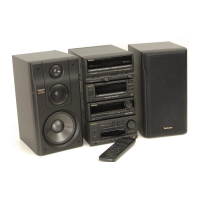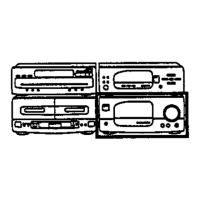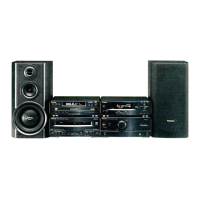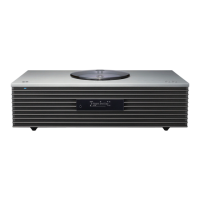Do you have a question about the Technics SC-CH750 and is the answer not in the manual?
| Type | Stereo System |
|---|---|
| Manufacturer | Technics |
| Model | SC-CH750 |
| Tuner Bands | FM/AM |
| CD Player Type | Single disc |
| Cassette Deck Type | Double Cassette Deck |
| Frequency Response | 20 Hz - 20 kHz |
| Power Supply | AC 220-240 V, 50/60 Hz |
| Components | CD Player, Cassette Deck, Tuner |
Details the buttons and indicators on the sound processor unit.
Details the buttons and indicators on the tuner amplifier unit.
Explains the various indicators and displays on the system.
Details the buttons and indicators on the compact disc player unit.
Explains the display indicators for the CD player functions.
Details the buttons and indicators on the cassette deck unit.
Explains the display indicators for the cassette deck functions.
Details common buttons on the remote control for system operation.
Details tuner-specific buttons on the remote control.
Details sound processor specific buttons on the remote control.
Details CD player specific buttons on the remote control.
Details cassette deck specific buttons on the remote control.
Explains how to mute the system's volume using the remote control.
Explains how to adjust the audio balance using the remote control.
Provides instructions for using headphones with the system.
Guides manual tuning and selection of FM/MW/LW radio stations.
Explains how to adjust MW frequency steps for better reception.
Explains how to select preset stations using the main unit.
Explains how to select preset stations using the remote control.
Explains how to play discs sequentially from the first to the last track.
Details how to remove a specific track from the programmed sequence.
Explains how to rapidly search forward or backward on a disc.
Explains how to skip tracks forward or backward during playback.
Guides on inserting cassettes and selecting playback modes.
Explains how to start CD playback directly from standby.
Explains how to start tape playback directly from standby.
Explains how to tune to the last used radio station from standby.
Explains the fade-in function used with Easy Play.
Guides recording from various sources like radio, CD, or tape.
Explains the Computer Control Record Tuning function.
Explains recording with EQ or SFP effects.
Instructions on how to erase recorded sound from a tape.
Explains the leader tape and its purpose.
Details automatic recording of CD tracks onto tape, adjusting for tape length.
Guides on selecting specific tracks for sequential CD recording using program play.
Instructions on how to stop the sequential CD recording process.
Explains the ATLS feature for setting optimal recording levels.
Guides on selecting specific tracks for fit editing using program play.
Instructions on how to stop the fit editing process.
Guides on selecting specific tracks for fade out editing using program play.
Instructions on how to stop the fade out editing process.
Guides on selecting specific tracks for LINK recording using program play.
Explains how to use the demonstration mode for adjusting EQ and SFP settings.
Explains how to disable equalizer effects and return to FLAT mode.
Explains how to cancel the reverberation sound adjustment.
Explains how to adjust the curve slope (narrow/wide) for EQ settings.
Explains how to adjust the reverberation sound for SFP modes.
Explains how to recall stored EQ or SFP settings from memory.
Instructions on how to turn off the V. BASS effect.
Instructions on how to turn off the DNC effect.
Explains the purpose and benefits of the Dolby Pro-Logic Surround system.
Describes the four available Dolby Pro-Logic modes based on speaker setup.
Explains how to cancel the Dolby Pro-Logic mode and return to FLAT.
Guides on how to adjust delay time after bass/treble settings.
Instructions on how to cancel bass/treble level adjustments.
Guides on setting the timer to play a sound source at a desired time.
Explains how to verify the set play timer details.
Instructions on how to deactivate the play timer mode.
Guides on activating the system after timer settings are done.
Explains how to verify the set record timer details.
Instructions on how to deactivate the record timer mode.
Guides on activating the system after record timer settings are done.
Explains how to check the remaining time for the sleep timer.
Instructions on how to deactivate the sleep timer mode.
Explains the priority order when timer modes overlap.
Guides on how to mix microphone sound with music for karaoke.
Explains how to adjust the musical key for karaoke (model SH-CH750 only).
Explains how to adjust the reverb sound for karaoke (specific models/regions).
Guides on using the karaoke feature with a video disc player.
Explains how to select and play external audio sources.
Guides on recording from external sources onto tape.
Notes on recording limitations for DAT/video tapes.
Explains how to switch external visual sources.
Guides on recording audio from the system onto a video tape.
Describes the different spectrum analyzer display modes.
Explains how to view EQ curves alongside the spectrum analysis.
Provides advice on selecting, using, and storing cassette tapes.
Provides precautions and storage advice for compact discs.
Details how to handle compact discs to prevent damage.
Lists recommended and prohibited locations for storing discs.
Explains how to clean the tape heads, pinch roller, and capstan for optimal sound.
Recommends head demagnetization to maintain sound quality and prevent noise.
Provides instructions for cleaning the unit's exterior surfaces.
Addresses common issues like no sound, reversed audio, or single speaker output.
Troubleshoots FM reception issues like noise and signal disappearance.
Troubleshoots issues with TV picture interference.
Troubleshoots tape playback problems like low quality or deck errors.
Troubleshoots CD playback issues like tray errors or disc not playing.
Troubleshoots problems with the remote control operation.
Guides on connecting a DCC deck to the sound processor.
Guides on operating the connected DCC player.











